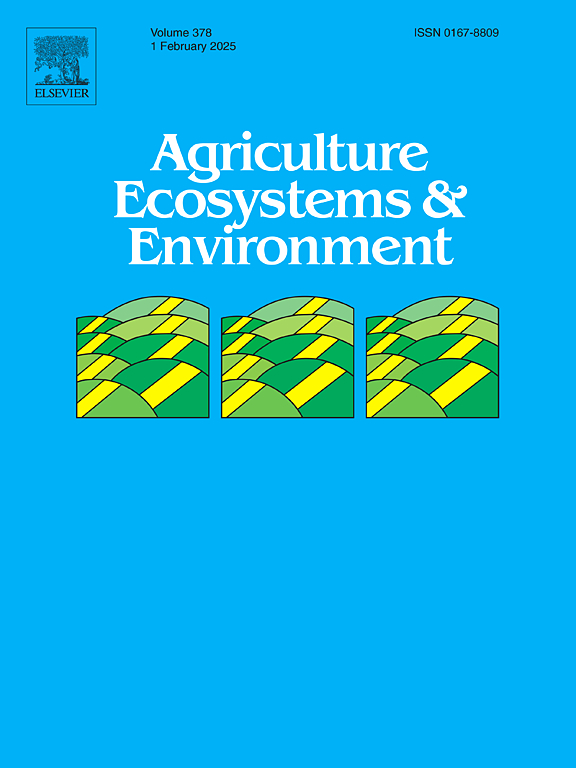长期淹水做法对稻田动物群落影响的实验测试
IF 6
1区 农林科学
Q1 AGRICULTURE, MULTIDISCIPLINARY
引用次数: 0
摘要
尽管环境友好型水稻种植有望促进稻田生物多样性保护,但对水稻种植中个别管理措施的影响的科学测试仍处于早期阶段。本研究通过田间试验来量化冬季淹水和夏季中季排水(水稻生长季节中期的短期土壤干燥)对稻田动物群落的影响。我们采用 2×2 因子设计,将冬季淹水(±)和季中排水处理(±)这两个因子进行交叉,每个组合有三个重复稻田(共 12 个)。田间试验表明,冬涝对淡水昆虫和蜘蛛的分类丰富度和丰度影响不大,但却增加了两栖动物(如山地褐蛙 Rana ornativentris 和日本黑鲵 Hynobius nigrescens)的卵块数量。相反,季节中期排水对淡水昆虫的分类丰富度和数量以及蜘蛛的数量产生了负面影响。特别是,幼虫期与季节中期排水期重叠的物种通常会死亡。冬季洪水促进了稻田动物群落的生物多样性。对于在早春繁殖的两栖动物来说,冬涝提供了繁殖栖息地。季中排水对动物群落的生物多样性有负面影响。推迟或停止季中排水可改善淡水昆虫的繁殖机会,保持物种多样性。在稻田景观中实现冬灌和冬干的多样化以及延长夏季灌溉的做法可能会改善保护效果。本文章由计算机程序翻译,如有差异,请以英文原文为准。
Experimental test of the effects of prolonged flooding practices on animal communities in rice paddy fields
Although environmentally friendly rice farming is expected to contribute to biodiversity conservation in paddy fields, scientific testing of the impact of individual management practices in rice cultivation is still in its early stages. This study used field experiments to quantify the effects of winter flooding and summer, mid-season drainage (a short-term soil drying in the middle of the rice growing season) on animal communities in paddy fields. We used a 2×2 factorial design with the factors winter flooding (±) and mid-season drainage treatment (±), crossed, and three replicate paddy fields in each combination (total n = 12). Our field experiments showed that winter flooding had little effect on the taxonomic richness and abundance of freshwater insects and spiders, but it increased the number of egg masses in amphibians such as the montane brown frog Rana ornativentris and the Japanese black salamander Hynobius nigrescens. In contrast, mid-season drainage negatively affected the taxonomic richness and abundance of freshwater insects, and the abundance of spiders. In particular, mortality usually occurred in species whose larval stage overlapped the period of mid-season drainage. Winter flooding promotes the biodiversity of animal communities in paddy fields. For amphibians that breed in the early spring, winter flooding provides breeding habitat. Mid-season drying had negative effects on animal biodiversity. Delaying or ceasing mid-season drainage would improve reproductive opportunities for freshwater insects and maintain species diversity. Diversification of winter flooding and winter drying across a rice paddy landscape and prolonged summer flooding practice may improve conservation outcomes.
求助全文
通过发布文献求助,成功后即可免费获取论文全文。
去求助
来源期刊

Agriculture, Ecosystems & Environment
环境科学-环境科学
CiteScore
11.70
自引率
9.10%
发文量
392
审稿时长
26 days
期刊介绍:
Agriculture, Ecosystems and Environment publishes scientific articles dealing with the interface between agroecosystems and the natural environment, specifically how agriculture influences the environment and how changes in that environment impact agroecosystems. Preference is given to papers from experimental and observational research at the field, system or landscape level, from studies that enhance our understanding of processes using data-based biophysical modelling, and papers that bridge scientific disciplines and integrate knowledge. All papers should be placed in an international or wide comparative context.
 求助内容:
求助内容: 应助结果提醒方式:
应助结果提醒方式:


